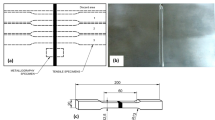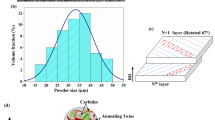Abstract
Compressive residual stress is a significant factor in influencing a fatigue failure of a mechanical component. In this perspective, the attempt has been made to induce beneficial compressive residual stress in Ti-6Al-4V alloy by using low plasticity burnishing process. The mechanism of LPB process includes rolling spherical balls made of tungsten carbide material over a material surface under fluid pressure supplied by a hydraulic unit. In this study, the cost-effective low plasticity burnishing tool with hydraulic fluid system is designed and fabricated. The LPB process was carried out on Ti-6Al-4V specimen with a suitable fixture. In this paper, the effect of burnishing process on residual stresses and cold working in Ti-6Al-4V was studied by using burnishing pressure and passes as a process parameter. The explicit module of the FE-Analysis code 6.17 was used with the aim of performing numerical simulation. The obtained experimentation results were considered to validate the results obtained by numerical FE analysis. It was found that there is good agreement between the experimental and numerical results. Both FEM simulation and experimentation results showed that hydraulic burnishing pressure is the most influential parameter in inducing beneficial compressive residual stress with less amount of coldwork.






















Similar content being viewed by others
References
P.S. Prevéy, L. Research, M.J. Shepard, P.R. Smith, and A. Mllmp, Low Plasticity Burnishing (Lpb) On The Hcf Performance And Fod The Effect Of Resistance Of Ti-6al-4v
A. Rodríguez, L.N. López de Lacalle, A. Celaya, A. Lamikiz, J. Albizuri, Surface improvement of shafts by the deep ball-burnishing technique. Surf. Coat. Technol. 206(11–12), 2817–2824 (2012). https://doi.org/10.1016/j.surfcoat.2011.11.045
N.H. Loh, S.C. Tam, Effects of ball burnishing parameters on surface finish A literature survey and discussion (1988)
R. Avilés, J. Albizuri, A. Rodríguez, L.N. López de Lacalle, On the fatigue strength of ball burnished mechanical elements. Mech. Mach. Sci. 17, 365–373 (2014). https://doi.org/10.1007/978-94-007-7485-8_45
Y. Hua, Z. Liu, B. Wang, J. Jiang, Residual Stress Regenerated on Low Plasticity Burnished Inconel 718 Surface After Initial Turning Process. J. Manuf. Sci. Eng. (2019). https://doi.org/10.1115/1.4045060
Harish, D. Shivalingappa, P. Vishnu, and Sampath Kumaran, Impact of Ball burnishing process parameters on surface Integrity of an Aluminium 2024 Alloy, in IOP Conference Series: Materials Science and Engineering, Jun. 2018, vol. 376, no. 1, https://doi.org/10.1088/1757-899x/376/1/012099
A. Harish, D. Shivalingappa, The influence of ball and roller burnishing process parameters on surface integrity of Al 2024 alloy. Materials Today: Proceedings 27, 1337–1340 (2020). https://doi.org/10.1016/j.matpr.2020.02.614
R. Scott, D. Ii, Investigation of Spherical Bearings for Use in the UltraForm Investigation of Spherical Bearings for Use in the UltraForm Finishing Polishing Process Finishing Polishing Process. https://scholarworks.rit.edu/theses
Y. Zhang, J.C. Outeiro, T. Mabrouki, On the selection of Johnson-Cook constitutive model parameters for Ti-6Al-4V using three types of numerical models of orthogonal cutting. Procedia CIRP 31, 112–117 (2015). https://doi.org/10.1016/j.procir.2015.03.052
P. Sartkulvanich, T. Altan, F. Jasso, C. Rodriguez, Finite element modeling of hard roller burnishing: An analysis on the effects of process parameters upon surface finish and residual stresses. J. Manuf. Sci. Eng. Trans. ASME 129(4), 705–716 (2007). https://doi.org/10.1115/1.2738121
Z. Zhang, Q. Sun, C. Li, W. Zhao, Theoretical calculation of the strain-hardening exponent and the strength coefficient of metallic materials. J. Mater. Eng. Perform. 15(1), 19–22 (2006). https://doi.org/10.1361/10599490524057
Author information
Authors and Affiliations
Corresponding author
Additional information
Publisher's Note
Springer Nature remains neutral with regard to jurisdictional claims in published maps and institutional affiliations.
Rights and permissions
About this article
Cite this article
Harish, Shivalingappa, D. & Raghavendra, N. The Impact of Low Plasticity Burnishing Process Parameters on Residual Stress and Percentage of Cold Working Distribution in Ti-6Al-4V Alloy. J Fail. Anal. and Preven. 21, 410–418 (2021). https://doi.org/10.1007/s11668-021-01113-x
Received:
Revised:
Accepted:
Published:
Issue Date:
DOI: https://doi.org/10.1007/s11668-021-01113-x




